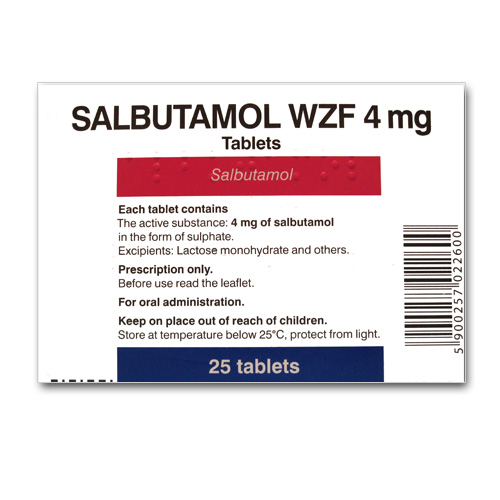Salbutamol is one of the most commonly prescribed medications for asthma relief, and it is known for its quick action in easing breathing difficulties.
Often administered through an inhaler, Salbutamol is a type of bronchodilator that works by relaxing the muscles around the airways, making it easier for people with asthma to breathe during an attack or when symptoms worsen.
This fast-acting medication is especially beneficial for those experiencing sudden asthma flare-ups, providing relief within minutes.
Understanding how effective Salbutamol is for asthma management, including its short- and long-term uses, can help patients make informed decisions about their asthma treatment plan.

How Salbutamol Works to Relieve Asthma Symptoms
Salbutamol functions as a bronchodilator, targeting the beta-2 receptors in the lungs. These receptors control the smooth muscles surrounding the airways.
When Salbutamol is administered, it stimulates these receptors, prompting the muscles to relax and widen the airways. This rapid response helps reduce symptoms of wheezing, coughing, and shortness of breath, often within five to ten minutes of use.
Known as a “rescue” medication, Salbutamol is especially useful during asthma attacks or when symptoms become severe.
Unlike long-term control medications, Salbutamol provides only immediate relief, making it a crucial part of managing sudden flare-ups but not a replacement for daily preventative measures.
For those with mild asthma or infrequent symptoms, Salbutamol may be sufficient. Still, for those with more persistent symptoms, it’s recommended to combine Salbutamol with long-term asthma treatments that manage underlying inflammation.
Salbutamol plays a crucial role in asthma care by providing swift symptom relief, but it is most effective when part of a comprehensive treatment plan.
Short-Term vs. Long-Term Effectiveness of Salbutamol
Salbutamol is highly effective for managing short-term asthma symptoms, providing almost immediate relief during acute episodes.
When inhaled, it quickly relaxes airway muscles, allowing for easier breathing and providing a fast-acting solution for sudden asthma attacks.
However, its long-term role is limited, as Salbutamol does not address the root cause of asthma, which often involves chronic inflammation. Overreliance on Salbutamol for long-term management can lead to decreased effectiveness and may not prevent the progression of asthma symptoms.
Many asthma management plans include daily preventative medications, such as inhaled corticosteroids, to reduce inflammation and lower the frequency of symptoms over time. While Salbutamol is essential for managing acute episodes, it’s intended for occasional use.
Consistent overuse may signal poorly controlled asthma and necessitates a review with a healthcare provider.
Thus, while Salbutamol is highly effective in the short term, its role in long-term asthma management is limited and requires supplementary treatments for optimal control.
Important Safety Considerations for Salbutamol Use
Using Salbutamol effectively and safely requires following the prescribed dosage and understanding potential safety considerations. Salbutamol is generally safe, but overuse can diminish effectiveness as the body adapts to its presence.
It’s recommended to use Salbutamol only as directed, as exceeding the dosage can cause increased heart rate, tremors, and restlessness.
For individuals with heart conditions or high blood pressure, consulting with a healthcare provider before using Salbutamol is essential, as these conditions can make side effects more pronounced.
Another critical safety consideration is recognizing when Salbutamol alone is insufficient. If Salbutamol use becomes frequent—more than twice a week, for example—it may indicate that asthma is not well-controlled, and additional or alternative medications may be required.
Storing Salbutamol correctly, away from heat and light, also ensures its effectiveness. Safe Salbutamol use involves adhering to prescribed guidelines and staying mindful of symptom patterns or changes in medication needs.
When to Use Salbutamol for Optimal Asthma Control
Understanding when to use Salbutamol is critical to managing asthma effectively. Salbutamol is intended primarily for quick relief during acute asthma symptoms, such as sudden shortness of breath, chest tightness, or wheezing. Using it at the onset of symptoms can help prevent an asthma attack from worsening.
For those with exercise-induced asthma, using Salbutamol approximately 15-20 minutes before physical activity can help prevent symptoms from arising. However, Salbutamol should not be used as a preventative measure for daily asthma control.
If asthma symptoms are frequent, additional medications, like inhaled corticosteroids, may be necessary to maintain long-term stability.
It’s also essential for users to monitor their Salbutamol usage; relying on it too often may indicate poorly managed asthma, prompting a healthcare consultation.
Following a consistent asthma management plan and using Salbutamol during specific instances can help optimize asthma control, reduce symptom frequency, and improve quality of life.

Global Salbutamol Market Size Forecast 2022-2032
The global Salbutamol market is projected to grow steadily from 2022 to 2032, driven by rising asthma and respiratory disease cases worldwide.
With increasing awareness about effective asthma management and an expanding patient population, the demand for Salbutamol, known for its quick relief properties in managing bronchospasms, continues to rise.
Additionally, advancements in inhaler technology, prescription, and over-the-counter options have made Salbutamol more accessible, supporting its market growth.
The trend toward self-care and managing chronic respiratory conditions at home has also bolstered demand as individuals seek reliable, fast-acting solutions for symptom relief.
Furthermore, pharmaceutical companies’ ongoing investment in respiratory health is expected to lead to improved formulations and expanded distribution channels, sustaining the growth of the Salbutamol market over the forecast period.
Conclusion: Is Salbutamol the Right Choice for Asthma Management?
Salbutamol is a practical, fast-acting medication that provides relief during acute asthma episodes, making it an essential tool for managing sudden symptoms.
However, it is primarily a short-term solution, best used as a quick-relief medication rather than a long-term treatment.
For those experiencing frequent asthma symptoms, combining Salbutamol with long-term preventive medications may provide a more comprehensive approach to asthma management. Patients can better control their symptoms and make informed decisions about their asthma care by understanding how and when to use Salbutamol.





